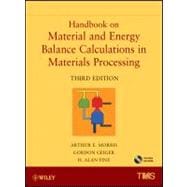
Note: Supplemental materials are not guaranteed with Rental or Used book purchases.
Purchase Benefits
What is included with this book?
Arthur E. Morris is Professor Emeritus of Metallurgical Engineering in the Department of Metallurgical Engineering at the Missouri University of Science and Technology—Rolla, where he taught for thirty years. A consultant to several industrial corporations, he was asked by the U.S. Bureau of Mines to organize a new department-wide research group—the Generic Mineral Technology Center for Pyrometallurgy, where he was principal investigator until his retirement in 1996. He has prepared CDs for other texts and developed short courses on materials processing, as well as publishing nearly seventy papers on various aspects of the subject.
Preface to the Third Edition xvii
Acknowledgements xix
Chapter 1. Dimensions, Units, and Conversion Factors 1
1.1 The SI System of Units 1
1.2 The American Engineering System (AES) of Units 4
1.3 Conversion of Units 6
1.4 Unit Conversions Using the U-Converter Program 11
1.5 Amount of Substance – the Mole Unit 11
1.6 Density and Concentration 13
1.7 Electrical Units 20
1.8 Calculation Guidelines 21
1.9 Summary 22
Chapter 2. Thermophysical and Related Properties of Materials 26
2.1 State of a System and Properties of a Substance 26
2.2 The Gibbs Physical Rule 27
2.3 The Gas Phase 30
2.4 Condensed Phases 34
2.5 Vapor-Liquid Equilibrium (VLE) 35
2.6 Effect of Pressure on Phase Transformation Temperatures 42
2.7 Stream and Air Property Calculators 44
2.8 Properties of Solutions 44
2.9 Summary 50
Chapter 3. Statistical Concepts Applied to Measurement and Sampling 54
3.1 Basic Statistical Concepts and Descriptive Tools 55
3.2 Distributions of Random Variables 62
3.3 Basic Applications of Inferential Statistics to Measurement 75
3.4 Curve Fitting 95
3.5 Experimental Design 119
3.6 Summary 137
Chapter 4. Fundamentals of Materials Balances with Applications to Non-Reacting Systems 144
4.1 System Characteristics 144
4.2 Process Classifications 145
4.3 Flowsheets 146
4.4 The General Balance Equation 150
4.5 Material Balances on Simple Non-Reactive Systems 151
4.6 Strategy for Making Material Balance Calculations 154
4.7 Degree-of-Freedom Analysis 158
4.8 Using Excel-based Calculations Tools to Solve Equations 174
4.9 Balances on Systems with Multiple Devices 179
4.10 Extension of Excel’s Calculational Tools for Repetitive Solving 194
4.11 Special Multiple-Device Configurations I – Recycle and Bypass 197
4.12 Special Multiple-Device Configurations II – Counter-Current Flow 205
4.13 Using FlowBal for Material Balance Calculations 216
4.14 Continuous-Mixing Devices 223
4.15 Graphical Representation of Material Balances 232
4.16 Measures of Performance 232
4.17 Controllers 234
4.18 Summary 239
Chapter 5. Stoichiometry and the Chemical Equation 248
5.1 Atomic and Molecular Mass 248
5.2 Composition of Compounds and the Gravimetric Factor 249
5.3 Writing and Balancing Chemical Equations 251
5.4 Calculations Involving Excess and Limiting Reactants 256
5.5 Progress of a Reaction 258
5.6 Practical Indicators of the Progress of Reactions and Processes 269
5.7 Parallel, Sequential and Mixed Reactions 273
5.8 Independence of Chemical Reactions 274
5.9 Practical Examples of Reaction Writing and Stoichiometry 274
5.10 Use of Chemical Reactions in FlowBal 279
5.11 Balancing Aqueous (Ionic) Reactions 283
5.12 Summary 286
Chapter 6. Reactive Material Balances 294
6.1 The General Material Balance Procedure for a Reactive System 294
6.2 The Use of Excel-based Computational Tools in Reactive System Balances 306
6.3 Combustion Material Balances 321
6.4 The Production of a Reducing Gas 340
6.5 Gas-Solid Oxidation-Reduction Processes 345
6.6 The Production of Gases with Controlled Oxygen and Carbon Potential 370
6.7 Processes Controlled by Chemical Reaction Kinetics 371
6.8 The Reconciliation of an Existing Materials Balance 372
6.9 The Use of Distribution Coefficients in Material Balance Calculations 377
6.10 Time-Varying Processes 384
6.11 Systems Containing Aqueous Electrolytes 389
6.12 Summary 402
Chapter 7. Energy and the First Law of Thermodynamics 410
7.1 Principles and Definitions 410
7.2 General Statement of the First Law of Thermodynamics 413
7.3 First Law for an Open System 415
7.4 Enthalpy, Heat Capacity, and Heat Content 416
7.5 Enthalpy Change of Phase Transformations 418
7.6 Enthalpy Change of Chemical Reactions 420
7.7 Thermodynamic Databases for Pure Substances 421
7.8 Effect of Temperature on Heat of Reaction 426
7.9 The Properties of Steam and Compressed Air 431
7.10 The Use of FREED in Making Heat Balances 437
7.11 Heat of Solution 441
7.12 Summary 445
Chapter 8. Enthalpy Balances in Non-Reactive Systems 450
8.1 Combined Material and Heat (System) Balances 450
8.2 Heat Balances for Adiabatic Processes 458
8.3 Psychometric Calculations 462
8.4 Energy Efficiency 468
8.5 Recovery and Recycling of Heat 469
8.6 Multiple-Device System Balances 483
8.7 Use of FlowBal for System Balances 488
8.8 Heat Balances Involving Solution Phases 494
8.9 Enthalpy Change During Dissolution of an Electrolyte 496
8.10 Graphical Representation of a Heat Balance 499
8.11 Summary 500
Chapter 9. System Balances on Reactive Processes 505
9.1 Thermal Constraints on a Material Balance 505
9.2 Combustion of Fuels 511
9.3 Adiabatic Processes 517
9.4 System Balances Using FlowBal 533
9.5 Quality of Heat and Thermal Efficiency 542
9.6 System Balances with Heat Exchangers 548
9.7 Aqueous Processes 565
9.8 Electrolytic Processes 571
9.9 Summary 573
Chapter 10. Case Studies 577
10.1 Material Balance for an H-Iron Reduction Process with Gas Tempering and Recycle 577
10.2 Mass and Heat Balance Simulation for the Use of DRI in EAF Steelmaking 581
10.3 Natural Gas Combustion Control and the Wobbe Index 588
10.4 Reduction of Hematite to Magnetite 592
10.5 Conversion of Quartz to Cristobalite in a Fluidized Bed 598
Appendix. Computational Tools for Making Material and Heat Balance Calculations 601
General References 605
Index 606
The New copy of this book will include any supplemental materials advertised. Please check the title of the book to determine if it should include any access cards, study guides, lab manuals, CDs, etc.
The Used, Rental and eBook copies of this book are not guaranteed to include any supplemental materials. Typically, only the book itself is included. This is true even if the title states it includes any access cards, study guides, lab manuals, CDs, etc.